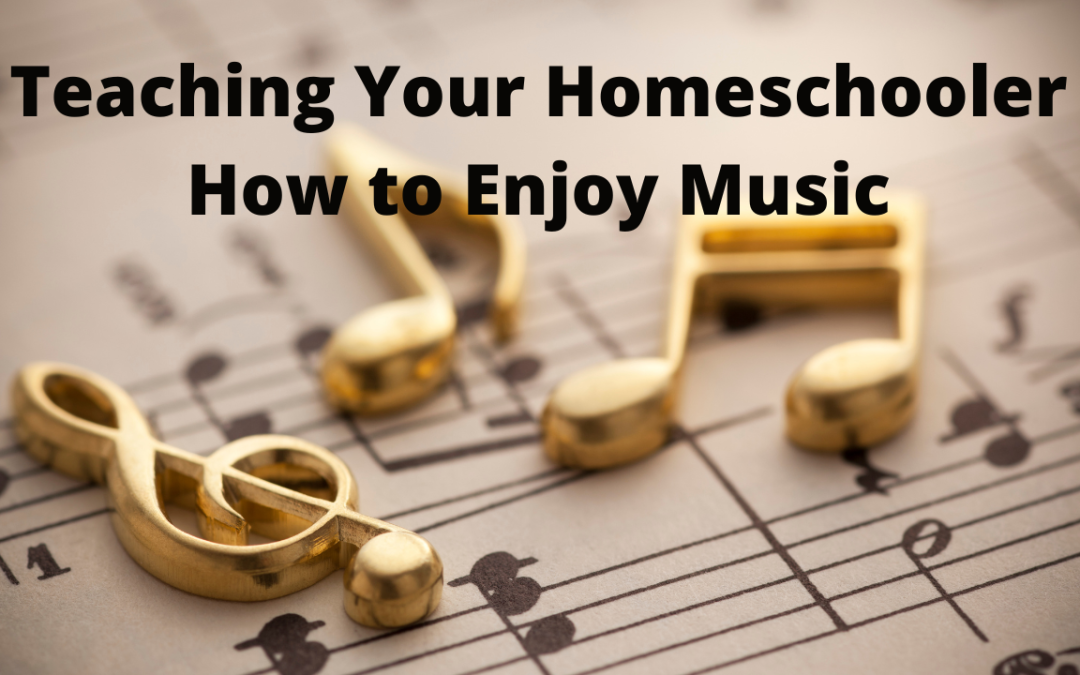During nine years of writing for the homeschooling market, I’ve been disappointed many times to discover that homeschool curricula often do not include Art and Music. These studies have always been the first to fall off course lists when money is limited, or schedules are tight.
Dropping off music appreciation from your core studies list shortchanges your child because. when taught correctly, music appreciation can help teach:
- An understanding of different cultures,
- A knowledge of historical events,
- A way to express personal interests, and
- The ability to tap into inspirations and beautiful thoughts.
HOW TO TEACH MUSIC APPRECIATION TO HOME SCHOOLERS
Unfortunately, homeschool parents sometimes avoid teaching music appreciation because they either don’t have a background in music, or they simply do not feel comfortable teaching the topic even though they recognize its importance.
The main thing to remember is that, as in so many areas of homeschooling, you should be willing to educate yourself at the same time you educate your child.
The best way to start teaching music appreciation to your child is to begin with something FUN! Start with a music genre that’s approachable for your homeschool student and move from genre to genre over the course of the school year. There’s no requirement to start with, or teach only, classical music.
Ask your student to name their favorite music star, identify the genre, and start from there! A music genre provides a great way to categorize your teaching into easy-to-recognize “types” of music. Read stories and biographies about the artists. Play their hit songs and ask your children why they enjoy a song, singer, or musician. Work with your child to learn to recognize the different instruments being played in their favorite tunes. Show them photos of the instruments and play examples of how the instrument sounds in other music selections.
WHAT IS A MUSIC “GENRE?”
According to the website www.academickids.com/encyclopedia/index.php/Musical_genre, a music genre is “a category (or genre) of pieces of music that share a certain style or basic musical language. Music can also be categorized by non-musical criteria such as geographical origin.”
A short list of music genres could include:
- Rock
- Electronic
- Soul
- Rhythm and Blues
- Funk
- Country Western
- Bluegrass
- Gospel
- Classical
- Reggae
- Punk Rock
For a more complete listing of music genres visit: Genres of Music | Defining Different Types of Genres | Мusic Gateway (musicgateway.com).
In addition to expanding your student’s ability to enjoy music, teaching music genres in homeschool helps kids develop their own interests, and teaches them about culture and history.
SUGGESTION: Start with modern music. Music your student can immediately recognize. Save classical music for another, more advanced, music appreciation class. Start with one specific musical genre and study that for a month. Then move on to another genre.
FINDING THE MUSIC AND METHOD
The cool thing is – you don’t have to OWN the music. Any music you want to introduce to your kids is available FREE on YouTube, Amazon Music, Pandora – endlessly! You can also ask Alexa or Siri to play any tune you’re looking for – and she will!
If you feel you’re not qualified to write your own music appreciation homeschool curriculum, conduct a quick Internet search for music appreciation programs. LOTS of stuff available! Many of the programs are geared towards classical music, but you can pull out some great ideas for teaching any music genre your student wants to study. (For music appreciation curriculum suggestions, GOTO: https://reneeatgreatpeace.com/music-appreciation-curricula )
One way to study music with your kids is to listen together to a music selection and then analyze the sounds you both hear. You don’t need a PhD or degree in music to do this. There are no right or wrong answers – just listening and enjoying the music. Ask your child what kinds of sounds they’re hearing – strings, percussion, woodwinds, piano, organ, synthesizer, etc. Then identify the instruments you hear, play a selection featuring each instrument, and perhaps even pull up an image of the instrument so your student recognizes what they’re hearing.
WHY TEACH MUSIC APPRECIATION TO HOMESCHOOLERS?
On a basic level, music appreciation adds an exciting element of opportunity for discovery and exploration to the homeschool classroom. It enriches the learning experience. On a more targeted level, music appreciation can:
- Develop a child’s language learning capacity,
- Help students learn to decode abstract concepts and ideas,
- Benefit language and intellectual development, and
- Add an important level of FUN to the homeschool classroom.
The National Center on Safe Supportive Learning Environments website reports that integrating music into the classroom can benefit student learning and development. Specifically, “exposure to music can improve learning and increase positive classroom atmospheres. Active engagement can impact the way that the brain processes information, enhancing the perception of language and speech and improving our ability to communicate with others and learn to read.” (SOURCE: How can integrating music into your classroom benefit student learning and development? | National Center on Safe Supportive Learning Environments (NCSSLE) (ed.gov))
Many people do not realize the effect music has on our lives. Here are 7 reasons why you should teach your homeschool student to love and appreciate music.
- Music can be a motivating force in our lives.
- Music can help us express our feelings.
- Music can bring people together.
- Music nurtures memories.
- Music is VAST – There are millions of music styles on earth.
- Music is timeless.
- Music can be healing and help mend what’s broken.
Music benefits life and education in so many ways – why not teach your children how to appreciate music?
“Music is to the soul what words are to the mind.” (Quote by Modest Mouse: “Music is to the soul what words are to the mind.” (goodreads.com))

